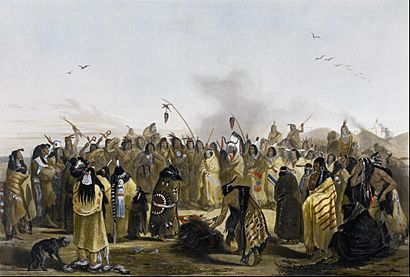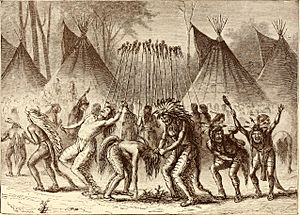Scalping facts for kids
Scalping is when someone cuts or tears off a piece of skin from the top of the head, usually with hair still on it. This often happened during wars, and the scalp was kept as a special prize or symbol. This practice happened in different cultures all over the world, both long ago and in more recent times. Getting scalped usually didn't kill someone right away. It often happened to people who were already badly hurt or had died.

Contents
Where did scalping happen?
Scalping was a practice found in many different places and times. It wasn't just in one part of the world.
Scalping in Europe
Scientists have found signs of scalping on ancient human remains from the Stone Age in Denmark. This shows it happened very long ago.
In England, around the year 1036, a powerful leader named Earl Godwin was said to have scalped his enemies. One of these enemies was Alfred Aetheling.
Scalping in Asia
There is also proof that scalping happened in ancient China during the Longshan and Erlitou periods. These were important times in Chinese history.
A skull found in South Siberia from the Iron Age also shows signs of scalping. Some evidence has also been found in the Indian Subcontinent.
Scalping in the Americas
There is a lot of archaeological proof that scalping happened in North America before Christopher Columbus arrived. Some skulls show signs of scalping from as early as 600 AD. Some even show that people survived being scalped for several months!
Among the Plains Indians, scalping was mainly done during wars between different tribes. They usually only took scalps from enemies who had been killed in battle.
Many Native American tribes practiced scalping, sometimes even until the late 1800s. When Europeans came to the Americas, it led to more conflicts between tribes. This also caused an increase in how often scalping happened.
How was scalping done?
The way scalping was done could be a bit different depending on the culture. However, the general process was quite similar. The scalp was carefully separated from the skull using a sharp tool.
The first tools used for scalping were knives made from stone like flint or obsidian. Other materials like reeds or oyster shells were also used if they could be made sharp enough. These tools were also used for everyday tasks, like preparing animals after a hunt. Later, metal knives became common after Europeans arrived and traded them.
Images for kids
-
Robert McGee survived being scalped as a child in 1864 by Sioux people. This photo was taken around 1890.
See also
 In Spanish: Escalpelamiento para niños
In Spanish: Escalpelamiento para niños





